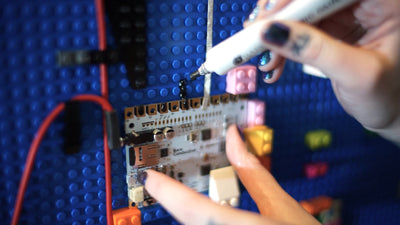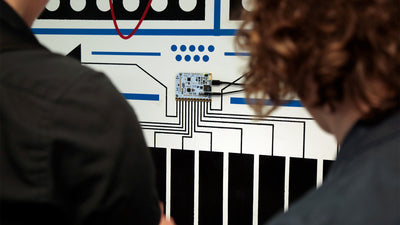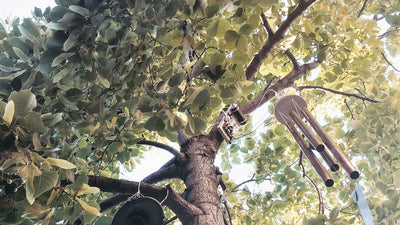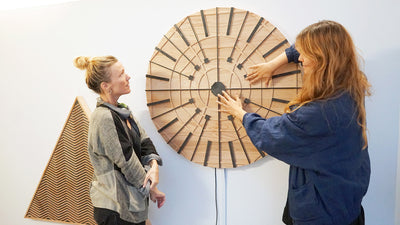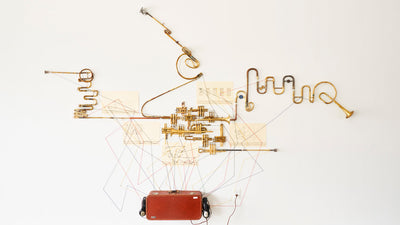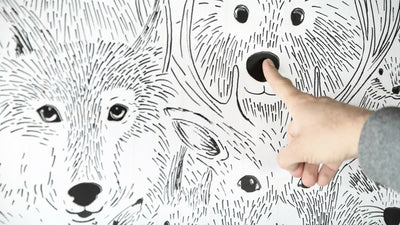1.5 Degrees of Concern - An Interactive Artwork About Living Through Global Climate Crises

The artwork invites listeners to interact with the objects. Touching, hovering over and exploring provides a multi-sensory experience that brings the listener into the complex narrative world of sounds, provides a mode of reflection and ultimately connects them to the urgency of climate crisis.
1.5 Degrees of Concern grew out of conversations between three artists from different continents who, prompted by their interest in interactive art, sound and technology, started meeting together online during the Covid-19 lockdowns: Kristine Diekman, media artist and educator from the US, Lisa Mansfield who works in media curation, technology and multisensory installation in Australia and Liz Waugh McManus, interdisciplinary artist and PhD researcher at University of Sunderland, exploring what she has coined ‘an Internet of glass things’ through traditional glass techniques and electronics tinkering.
1.5 Degrees of Concern, was initially created for ‘Rule 42: Stretched Language’, exhibition at Bonita Museum and Art Center in 2021. In 2022, 1.5 Degrees of Concern moved to the Michigan State University Science Gallery for its 1.5° Celsius exhibition. It was also long- listed for the Lumen Prize 2022, one of seventy art works chosen from 1500 submissions.
I.5 Degrees of Concern installation, Bonita Museum, California from McManus on Vimeo.
The artists wanted visitors to reflect on impacts of climate emergency on individuals and communities. They opted to use a multisensory approach in their artwork, using touch and proximity to invoke interactive stories, the first being about the 1953 North Sea flood disaster, a historical extreme weather event, and two speculative future scenarios, a drought- ridden California of 2053 and an iced-over Australian desert in 2153. Touch Boards were an obvious choice to realise the project as Kristine and Liz had used Touch Boards for previous projects.
The 1.5 Degrees of Concern art installation took the form of an array of natural, crafted and technological objects placed across a trestle table - books, feathers, molten glass and cyanotype plant specimens, driftwood and rocks - which located the stories and offered visual, tactile and sonic engagement. Touch Boards were embedded in ‘hacked’ books linked to each audio narrative, which included archival voices of flood survivors, letters and underground transmissions from drought affected communities, and poetic invitations for environmental regeneration.
The sonic arrangements, composed in Adobe Audition, were played through speakers also embedded in the books. At the same time, a background soundscape played from speakers placed in the configuration of a graph of projected global warming connected to the dates of the stories painted on the back wall.
Tactile and proximity sensors were made by applying copper tape, Electric Paint or conductive thread to book pages, a cyanotype photo plate, stones and feathers. These were attached to the Touch Boards with copper wires or crocodile clips. Spaces carved out of the books for the hardware included channels for the wires, positioned to avoid electrical interference. To encourage playful engagement, carbon coated sticks with copper on the ends were placed on the table so that people could pick up and touch the sensors.
The single sensor connected to an electrode linked to a folder of multiple audio files was a simple and effective approach for one book. Multiple sensors and amount of conductive material contained in the other books did cause some glitching with sounds activating without anyone touching the sensors. This may have been because the initial Touch Board sensitivity calibration was affected, or that nearby sensors were setting each other off. Simplifying the wiring and making sure all conductive materials were connected to separate electrodes solved this problem.
After considering ways they wanted users to interact, the artists selected Arduino sketches for starting, stopping or resuming the audio tracks. Some of the sensors were programmed so that the user had to keep in contact with the sensor in order to hear the stories, further connecting the listener through deep and prolonged listening. These were created by programmer Craig James, who also compiled a new version of the Random Touch sketch that ensured the same track did not repeat immediately after it had just played. Craig has created a range of sketches for using the Touch Board in workshop settings with non-coder participants, simplifying the code by creating a new library, BTUtils which includes additional features such as fades, time outs, continuing a track rather than restarting, and others. The software and the BTUtils library are available on Github.
At the exhibition, children and young people were quickest to engage with the artwork, however it was noted that many adults who engaged with it were visibly moved. Comments from museum staff at the exhibition suggested that the multisensory experience of the artwork, seeking out sensors, touching or hovering over them, meant viewers became more invested in listening to the narratives than if the sound element had played continuously. While the ambient sound on the speakers on the back wall drew the audience in and signalled that something was happening, it was movement and touch that prolonged their listening time, suggesting participants became engrossed in the narratives and responded more deeply to the stories than otherwise. The artists hope the interactive installation provided a mode of reflection that could ultimately connect people more deeply to the urgency of the climate crisis and its impact on individual lives.
We love it when you share your projects! Post your project on Instagram, YouTube, or Twitter, and make sure to tag @bareconductive or use #bareconductive. You can also send your videos and photos to info@bareconductive.com so we can post them on our site for the world to see.


